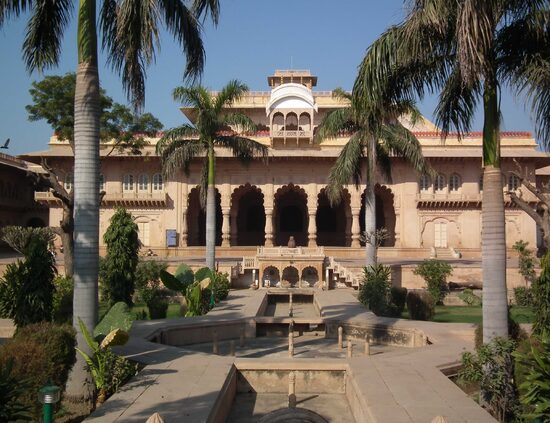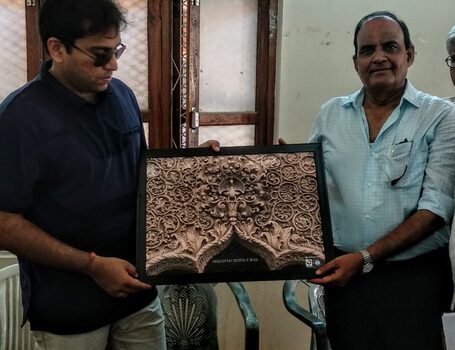Bharatpur Virasat Abhiyan
Lupin Human Welfare and Research Foundation (LWHRF) has been facilitating community mobilisation around the theme of sustainable development for more than two decades. It has evolved a unique model of development of communities in rural areas in the form of LUPIN Panchayats. It was realised that development without adequate regard for heritage was leading to an erosion of the unique identity for the place and community of Bharatpur. In this backdrop LWHRF set upon itself the task of mobilising popular opinion for a heritage centered development. Bharatpur Virasat Abhiyan was started with the advice of Centre for Advancement of Traditional Building Technology and Skills (CATTS) towards this end for creating heritage awareness through mobilization of communities.
As part of the initiative a detailed survey of the city was undertaken to map its built heritage. The objective of the entire documentation exercise was to create awareness about the built heritage of the city and create a database which would form the basis for formulating a strategy for heritage conservation. On the basis of the mapping exercise a book titled Bharatpur: Built Heritage Resource Mapping has been published by CATTS. The book besides giving an analytical account of the historic context of Bharatpur has an inventory of 353 heritage properties along with detailed maps giving precise location of each heritage property.This book is a humble attempt at understanding the city as seen by its inhabitants in order to give Bharatpur its rightful place not only on the cultural map of Rajasthan but also at the national level.
The initiative undertaken by LHWRF and CATTS is of critical importance in the light of the fact that over the years the historic built environment of Bharatpur has undergone rapid transformation. This initiative is a first of its kind, a small step towards the achievement of the larger objective of conservation and promotion of the built heritage of Bharatpur and marks the beginning of a new era of conservation and heritage based development in the city.
Bharatpur Heritage Walk
CATTS with its experience of working in Bharatpur for more than a decade has developed two thematic heritage walks for exploring the rich past of the city. One walk titled the ‘Story of the Artistic Grandeur of Bharatpur’ explores the magic of the historic bazaar street and the other walk the ‘Legend of the Invincible Lohagarh’ explores the heroic deeds of the Jat Maharajas within the precincts of the historic Lohagarh.
Years of hard work and perseverance finally saw the light of the day as the Bharatpur Heritage Walk conceptualized by CATTS was set into motion, one baby step at a time, and the historic Town Hall building left to die a slow death witnessed this new beginning. The doors of the abandoned historic building were opened and the neglected interiors were cleaned up to receive the guests and host the launch of the walk giving it a new lease of life and purpose. Since then CATTS has been conducting the walk in the city led by volunteers. This may just be a humble beginning but definitely a significant step forward.
India Heritage Hub
Traditional cities and towns are not mere collection of relicts, monuments and other historic buildings; instead are an inseparable part of our vibrant, dynamic and ever evolving “cultural heritage”. Having evolved over generations, undergoing innumerable transformations these settlements have accumulated a wealth of not only physical assets in the form of several layers of built fabric but also contain within them an intangible repository of traditional knowledge and skills.
There is an urgent need to preserve our cultural heritage resources. With this objective Centre for Advancement of Traditional Building Technology and Skills (CATTS) has set up India Heritage Hub, a creative cultural space. This creative initiative intends to document both tangible and intangible heritage resources in a holistic manner. It hopes to be able to rebuild a repository of our collective cultural resources documenting local heritage assets, traditional knowledge and skills with the active participation of people.
CATTS is seeking active participation from people who share the organization’s vision and objectives, and believe in the strength of our Cultural Heritage as the medium for creative expression and intercultural dialogue.
Shekhawati Heritage Hub
Shekhawati referred to as a ‘open air art gallery’ has the largest collection of painted buildings anywhere in the world. Several towns in the region are strewn with beautifully painted buildings. A number of havelis have been demolished to reclaim land for construction of shopping complexes and renovation of painted facades is rampant. CATTS, has been working to safeguard and promote the heritage of Shekhawati for more than a decade and has made several efforts to reach out to the stakeholders especially the local community. A unique campaign Shekhawati Virasat Abhiyan promoted by CATTS aims to safeguard the built heritage of Shekhawati by extending technical and financial assistance to owners of heritage buildings for conservation, repair and maintenance.
CATTS has made a significant headway in this direction and is undertaking conservation of Dangayach Haveli built in 1892 A.D. in Nawalgarh based on a novel model of Participatory Heritage Conservation. Both technical assistance and financial help is being provided by CATTS. The conservation works are being undertaken in phases. To make the effort self-sustainable and generate funds for the repair works adaptive reuse of the haveli has been undertaken. An interpretation and cultural resource center called the Shekhawati Heritage Hub has been set up within the haveli.
CATTS envisions to develop Shekhawati Heritage Hub as the node to explore and experience the vast region of Shekhawati, its art, architecture and culture all in one place. Through the activities of the Hub CATTS intends to preserve, interpret and valorize Shekhawati’s rich heritage, enrich visitor experience, revive and facilitate training in building craft skills, create synergy between conservation and tourism and encourage and facilitate participation of owners of heritage buildings and the local community in conservation.
Bharatpur: Unsung Ingenuity Valour & Splendour
Bharatpur, the impregnable and well-fortified capital of the kingdom ruled by Jat Maharajas was founded in 1733 A.D. The city was developed with a vision to serve as the capital of a large and powerful kingdom. It emerged as a node of power and culture in northern India during the post Mughal times. Political, religious, social and geographical forces endowed the city with a uniquely rich cultural wealth. Several generations of Jat rulers shaped its built environment.
Today, the city is known across the world for its unique bird reserve. What is less known is the natural, historic and social context in which this unique wetland got created; the rich repository of built heritage that was bequeathed; the popular nature of this kingdom of Jats.
The mapping exercise undertaken in the city revealed a wide variety of built heritage. Buildings like palaces, mansions, havelis, shops, bazaars, dharamshalas, temples, mosques, kachahari, fort, fortification wall, bastion, pavilions, chhatri, wells, tanks and ghats have been identified. In addition a number of ruins in the form of remnants of old structures dating from different time periods were also identified.
An exhibition titled Bharatpur: Unsung Ingenuity Valour & Splendour has been curated by CATTS to showcase and celebrate this hitherto unknown dimension of Bharatpur’s history and culture. The exhibition has been organized at the Indira Gandhi National Center for Arts (IGNCA), New Delhi as well as at the Jawahar Kala Kendra (JKK), Jaipur, Hindi Sahitya Academy, Bharatpur and Salim Ali Interpretation Centre, Keoladeo National Park, Bharatpur.
Revival of Building Crafts of Shekhawati
Shekhawati boasts of a distinct heritage deeply rooted in its culture. Several towns in the region are strewn with beautifully painted buildings. Shekhawati referred to as an ‘open air art gallery’ has the largest collection of painted buildings anywhere in the world. Beautifully painted havelis (mansions), temples, shops, chhatris (cenotaphs) and water harvesting structures such as wells and tanks make the heritage of Shekhawati unique. Painted havelis are a unique feature of towns in the region. Apart from the functional and structural aspects of construction that have been very skillfully achieved in a haveli, aesthetic aspects have also been equally exemplified. Several finishes and ornamentation techniques have been used to adorn the havelis. Mural paintings on lime plaster have been extensively used as an artistic medium for expression. Every inch of space displays a mastery of the technique of mural painting. Apart from wall painting stucco, sculpture work, gold painting and mirror inlay work are some of the other ornamentation techniques that have been employed with utmost perfection in havelis to adorn the wall surfaces.
CATTS has undertaken extensive research on the various wall finishing techniques of Shekhawati. Detailed work has been carried out on the technique of mural painting and attempts are underway for contemporary adaptation of traditional techniques for revival and promotion of this beautiful art form. Detailed work has been carried out on technique of mural painting for innovation and adaptation to contemporary needs.






























